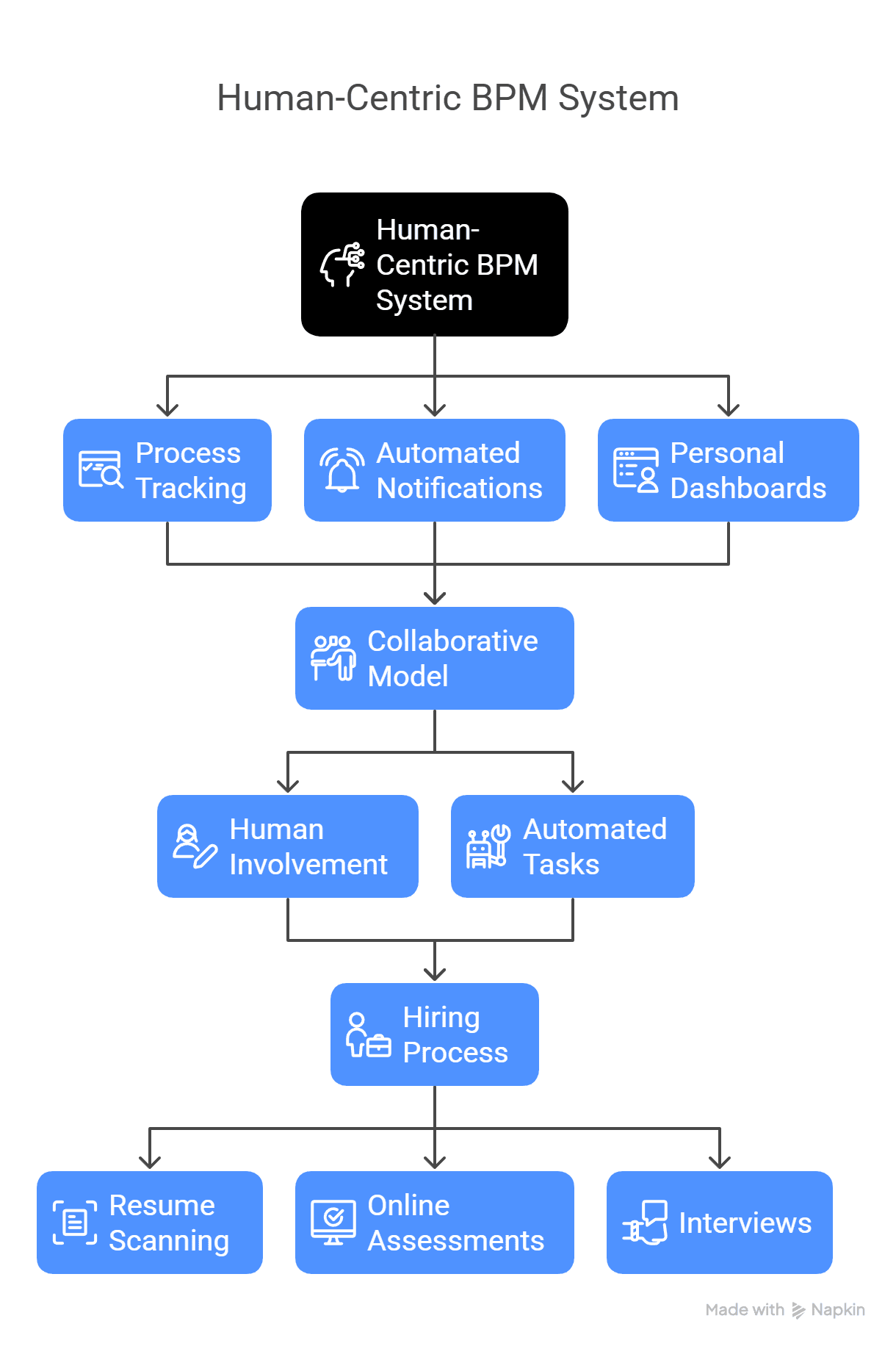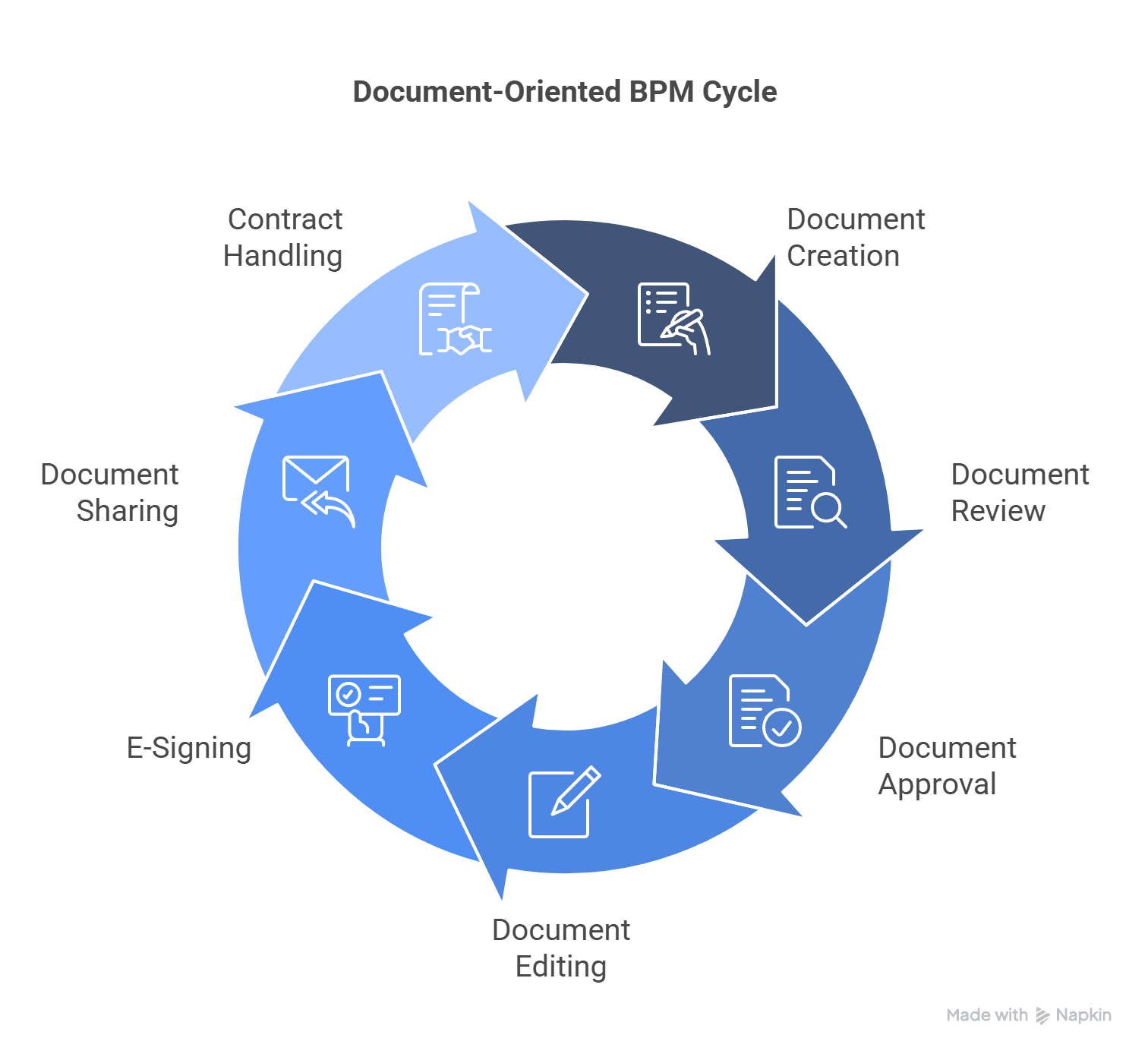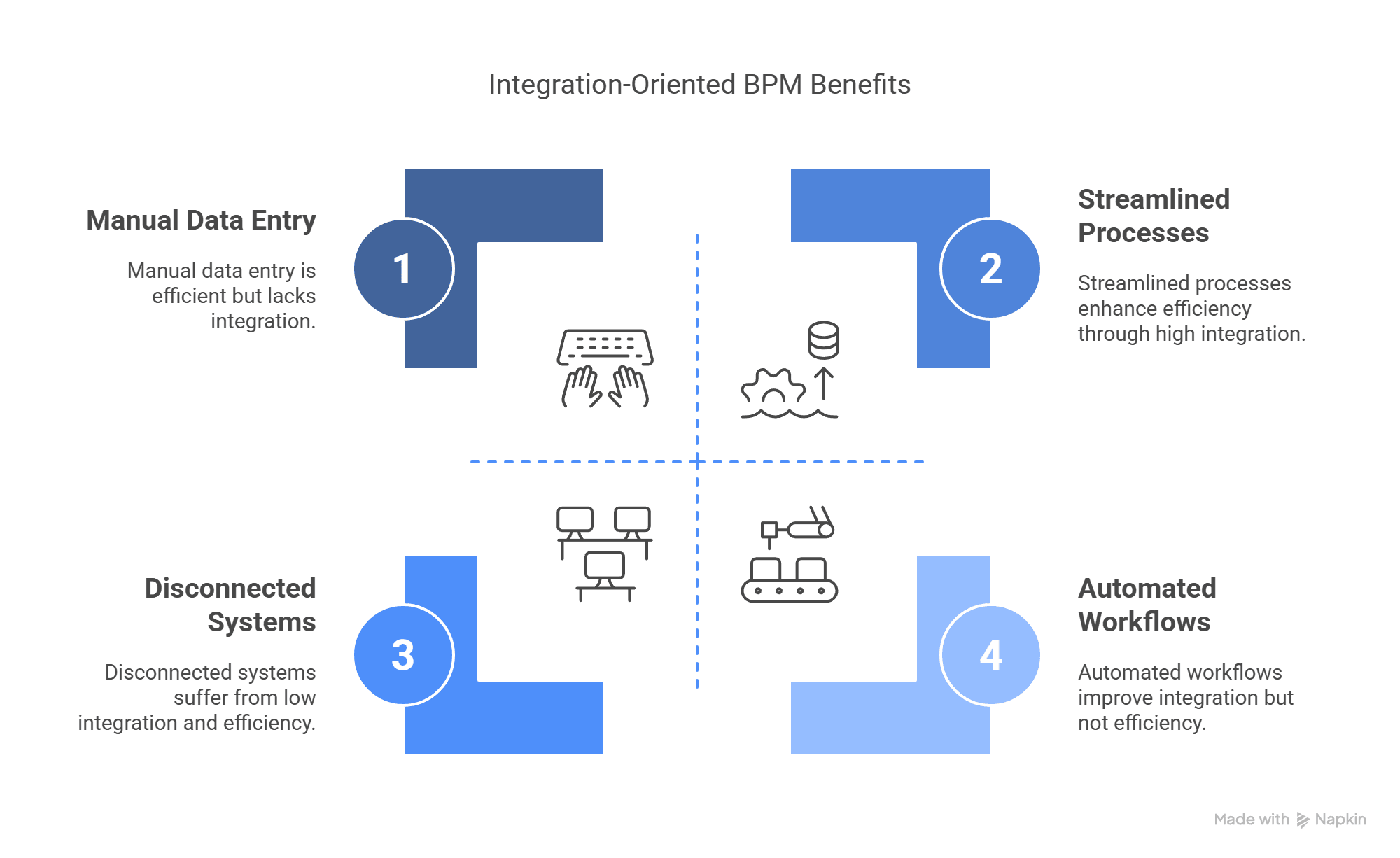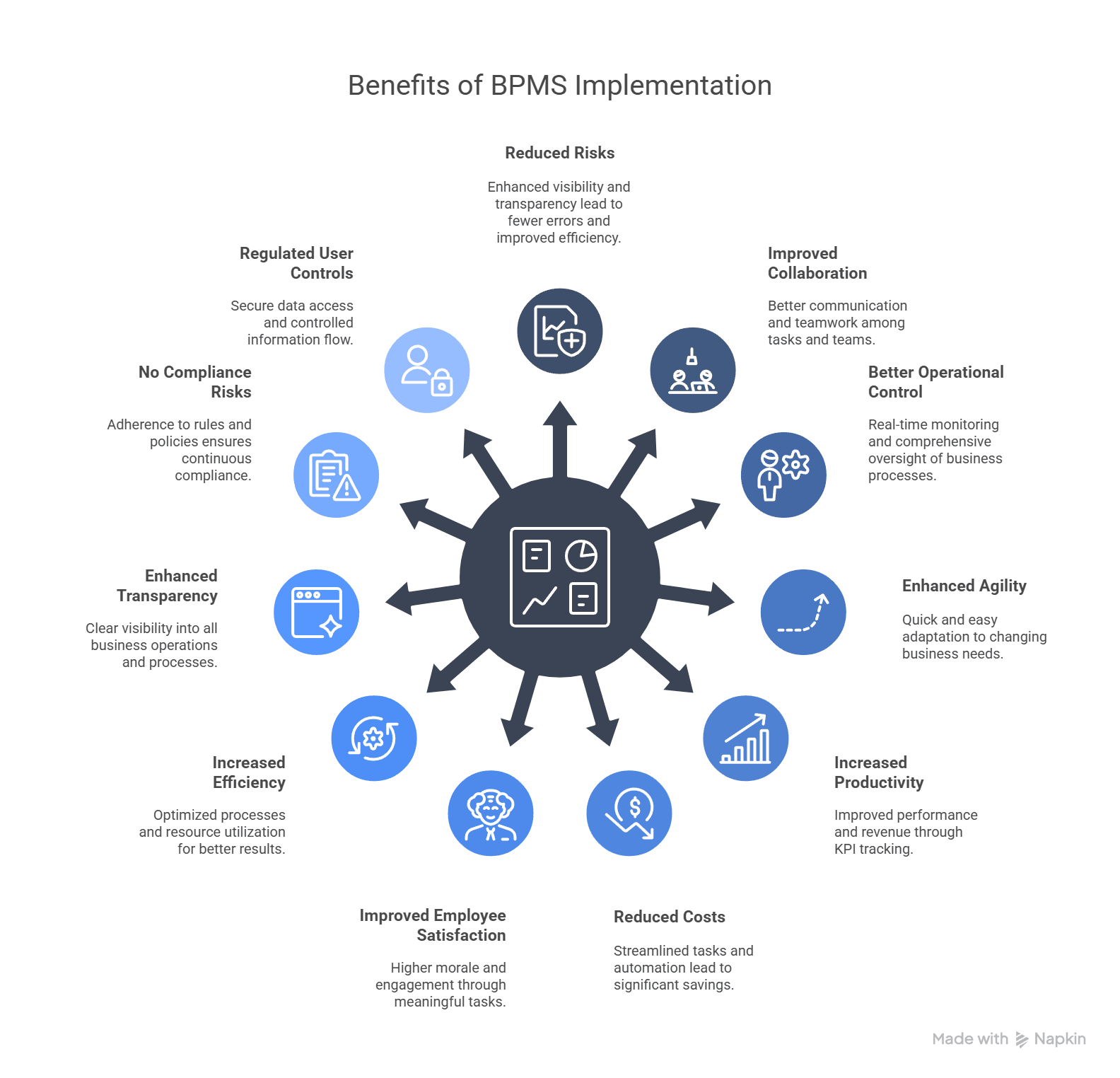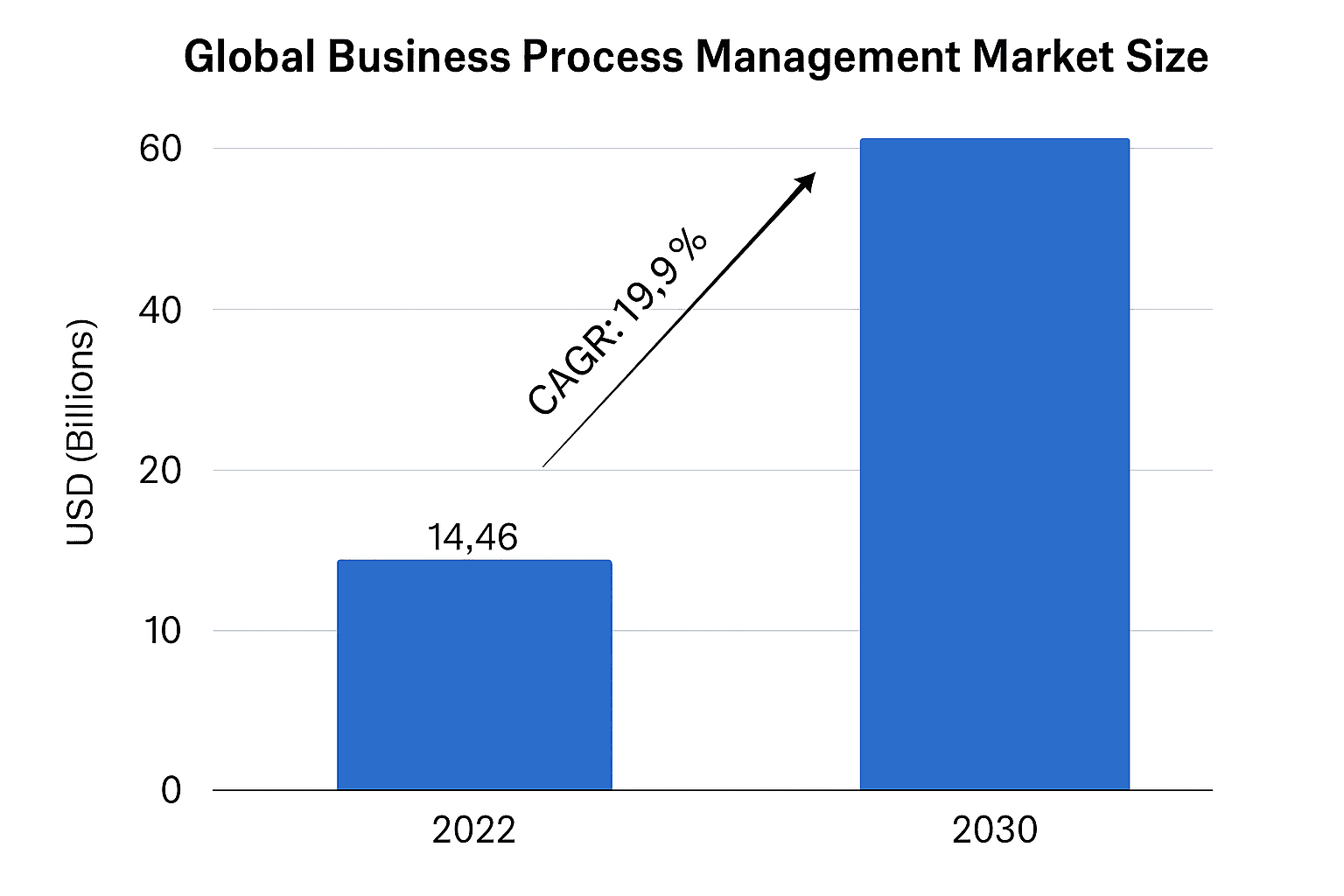Top 15 Business Process Management Software to Consider for 2025
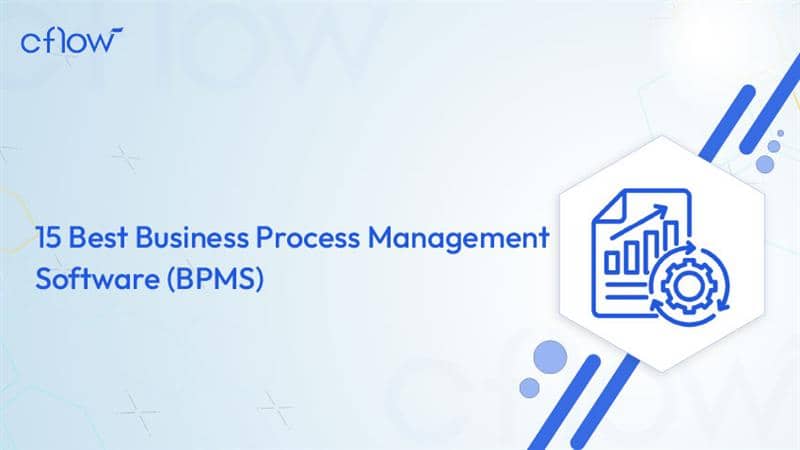
Key Takeaways
- Business Process Management (BPM) ensures seamless coordination between people, systems, and workflows by designing, modelling, executing, and optimising business processes to eliminate bottlenecks and improve efficiency.
- BPM software supports various process types—human-centric, document-centric, and integration-centric—offering tailored automation for approvals, document handling, and cross-system integrations.
- A complete BPM lifecycle involves five critical stages: design, modeling, execution, monitoring, and optimization—ensuring processes evolve continuously with business needs.
- Effective BPMS platforms offer must-have features like customisation, real-time analytics, role-based access, and omnichannel access to support compliance, agility, and operational visibility.
- Cflow’s no-code, AI-powered BPM solution enables teams to automate approvals, streamline operations, and implement organisation-wide process improvement without writing a single line of code.
Business runs on its people, systems, and processes. A perfect synergy of these 3 components is necessary for smooth business operations. Using business software for operations management helps you map out everyday processes to identify and eliminate bottlenecks, control the company’s costs, and make your day-to-day processes as efficient as possible.
Business process software also ensures the effectiveness of the people involved in your process. This blog explores the need for business process management, what business process management software is, and the best business process management software.
What is Business Process Management?
Organizations without clear procedures and streamlined processes are likely to end up with operational delays, security threats, and chaotic processes, which will ultimately affect the business’s bottom line. Guided by the right business process management (BPM software) principles, businesses can optimize their processes and teams can carry out their responsibilities on time for faster and more reliable results. Business process management is the creation, optimisation, implementation, and evaluation of specific processes in an organisation.
BPM software principles can be applied to operational activities that are repetitive, ongoing, and predictable. Most often, such tasks are tedious and time-consuming, and employees end up spending most of their work hours laboring over them. BPM forms the basis for workflow automation, which automates such tasks.
Organizations can streamline and automate repetitive tasks so that the teams are able to achieve important business milestones rather than labor over these tasks. Implementing BPM also helps reduce the incidence and cost of errors and delivers an excellent customer experience.
Unfortunately, most businesses debate implementing the best BPM software mainly due to the costs that come with it. They might be tempted to ignore the need for BPM software until processes are stable. It is not enough if processes just work, they need to work optimally. Optimal process performance is possible only when resources are utilised optimally and tasks are executed per preset business rules.
Even more established businesses experience challenges in certain aspects of their business, like onboarding, sales and marketing, hiring, etc, when processes span multiple departments. The key to improving process performance is to build a solid foundation for systemised business processes with BPM.
BPM software can help organisations achieve business objectives in many departments and functions.
Some of the departments that can achieve optimal performance via BPM include –
1. Accounts payable and receivable
Accelerating invoice reviews and approvals, avoiding late payments, and deeper visibility into process performance can be achieved by BPM.
2. Human resources
Processes like employee onboarding and automating document routing for approvals are some of the HR processes that can be automated using BPM software.
3. Compliance and risk management
BPMS software can help identify legal and financial risks and help internal audit teams track and resolve issues via alerts and notifications.
Based on the purpose of using BPM software, it is categorized into document-centric, human-centric, and integration-centric. Human-centric BPM is used for processes that are carried out by humans and usually require staff approvals. Document-centric BPM is when a document is at the core of the process. Integration-centric BPM is used between existing systems.
Three Types of Business Process Management
Human-centric BPM
A human-centric BPM system, as the name suggests, is specifically meant for processes that involve human interaction, like staff approvals and other manual labour. This business process software offers general tracking of the processes, automated notifications and personal dashboards for the employees. While operating this particular BPM system, it is a collaborative model that involves considerable human involvement and requires critical thinking and decision-making skills. Hence, the system is user-friendly and easy to navigate for all employees.
In a human-centric BPM, employees can create workflows for the processes and manage the tasks accordingly. Human involvement is specific to certain tasks, like preparing documents like proposals and contracts, or intellectual tasks like decision-making, translations, analysis of results, or even simple actions like uploading or submitting reports/documents. Therefore, along with these human-oriented activities, automated tasks are put together in a human-oriented BPM system.
The most essential process where a human-centric BPM can be employed is the hiring process. The hiring manager can gain control over the process by automating certain tasks like resume scanning, conducting online assessments, etc., and eventually set up limited candidates for interviews with the managers or chiefs.
Document-centric BPM
A document-oriented BPM system is where the document is placed at the core of the process and manages the entire process from document creation to approval. This particular BPM system revolves around process steps like document review, approval, editing, signing using e-signatures, sharing, and handling all document-based contracts and agreements.
It effectively eradicates the need to carry several paper-based documents across departments to get them approved manually. The document-oriented BMP software offers a platform where, with the help of limited resources, documents can be uploaded, reviewed, and approved effortlessly. Not only paper-based documents, but also automated business process management cloud software can eliminate the traditional and delayed process of getting approvals through emails. Unlike the human-centric approach, the documents are automated to work efficiently. Hence, essential processes like document management, project management, formatting of documents, and verification can all be streamlined effectively.
Integration-centric BPM
An integration-oriented BPM approach offers an overall integration and streamlining of all the organisational processes. Additionally, this BPM model also entails the integration of all the various applications, networks, systems, and tools like HRMS, CRM, ERP, payroll systems, etc., that are used by businesses. Unlike human-oriented BPM systems, these require minimal human involvement as the applications/software encourage API software connection. The business operations, when integrated, become more efficient and flexible.
Integration-centric BPM is best suited for complex business processes that involve multiple stages, including the involvement of different departments, and require more resources. Leveraging an integration tool is also the best solution that can effectively reduce the need for employees to constantly move between different files or systems to access certain data. Hence, this ensures a consistent flow of the processes.
This type of business process management offers notable advantages to the processes. Productivity increases with proper streamlining and improved efficiency. Errors, casual mistakes, and inaccuracies that are caused due to factors like miscommunication and manual delays are all successfully reduced to zero. Most importantly, the monitoring process becomes simpler, and users can employ measured control over the processes.
Steps in the BPM Software lifecycle
A deep understanding of the BPM lifecycle is essential to deploy growth-oriented strategies that suit your business. The BPM lifecycle is broken down into 5 stages that need to be executed in a sequence to achieve the desired business outcomes.
1. Design phase
The designing stage of the BPM software cycle thoroughly examines how a process is carried out. For instance, management could start interviewing employees and teams to understand how work is carried out. Talking to team members sheds light on how requests are approved, claims are managed, or payments are made. The relevant documents are also observed, and the people and resources involved in the process are identified. The design phase is when you take time to note all the challenges that are slowing the process.
2. Modelling phase
End-to-end observation of the process is carried out in the previous phase. In the modelling phase, a visual illustration of the process is created. Creating a process map is an important part of the modelling phase. The process map depicts the entire process, along with ways to optimise it and deliver the best outcomes. Teams can work with management to create a process model that maps existing processes accurately and highlights potential bottlenecks and scenarios that might arise in the future.
3. Execution phase
Once you have the process map ready, it becomes super easy to identify areas of improvement and changes that need to be made to the process. This part of the BPM cycle is utilised to test how a process would perform with smaller teams within a controlled setting. BPM stakeholders must document exactly which workflows are going to be changed and notify all the concerned parties about the changes. This is a very important step that ensures that business operations are not affected by the changes.
4. Monitoring phase
The monitoring phase of the BPM cycle mainly concerns regular tracking and monitoring of the progress of the newly implemented system. The management, team, and other stakeholders must come together periodically to follow up on the performance of the project. When done right, process monitoring helps teams identify new or unexpected workflow bottlenecks.
When such scenarios are encountered, the team has to gather complete information on what went wrong, at what stage it occurred, and whether team members must re-evaluate how the activity is performed.
5. Optimisation phase
Optimising the outlined business process is the final and most important phase of BPM. While optimising a process plan, you need to consider all the information on the process in the form of reports and metrics. A consolidated view of the process data helps make thorough improvements to efficiency.
It is important to consider BPM as an ongoing process improvement exercise, and not as a set-and-forget initiative. Success from BPM comes only when evaluation is ongoing and processes are improved and adapted to the organisation’s evolving demands.
What is Business Process Management Software?
Now that we have explored BPM concepts in detail, let us move to what business process management software is. Business process management software analyses, monitors, and transforms business processes based on BPM methodology. Business process management cloud software provides anytime, anywhere access to users, and real-time reports and analytics for making data-driven business decisions.
A business process management platform can be used for a variety of reasons
1. To review and analyse existing processes
This is the primary use of BPMS. Analysis and review of existing processes help in monitoring the performance of the process and identifying bottlenecks and areas of improvement. Continuous improvement of business processes ensures that business performance is optimised and expected outcomes are achieved.
2. Design new processes
BPM helps in analyzing business requirements thoroughly and designing processes according to the requirements. Improving existing processes is also based on the review and analysis of the process based on BPM methodologies.
3. Aligning business functions according to customer needs
The best BPM techniques can be followed to analyse customer needs and expectations. Once you have that data, it becomes easy to modify business functions according to the customer’s requirements. When business functions and operations are aligned with customer expectations and requirements, process outcomes are better.
4. Monitoring and measuring business resources
Effective resource utilisation is possible only when the right resource is assigned to the right job/role. Also, when a resource is not being utilised by a task or process, it must be released to the resource pool so that other tasks can use it. BPMS Software enables effective monitoring and measurement of business resources so that process resources are used optimally.
5. Optimising business processes
When a business process is designed, little attention is paid to the redundant or repetitive tasks that make up the process. Only once the process is operational do the redundancies crop up. Applying BPM methodologies to business processes eliminates redundant steps in the process and identifies repetitive, low-value steps that can be automated.
6. Checking costs to make daily operations more streamlined
The outcome of streamlining business processes to eliminate redundancies results in cost-cutting. When repetitive steps are automated, the time and costs associated with these steps are also reduced significantly. As a result, the process becomes cost-effective, and the execution time is also reduced significantly. Applying the Best BPMS software techniques to essential business processes is highly beneficial for the organisation in terms of cost and time savings.
7. Speed up process approvals
Best BPMS software alerts process owners on repetitive tasks that are causing excessive manual work for employees. Managers and team leads may be spending too much time reviewing and validating employee requests. Automating such processes speeds up approvals and frees managers from spending too much time reviewing requests.
Must-Have Features of BPM Software
Once you have chosen to implement business process management software, you need to mull over the features of business process management workflow software. The market is flooded with BPMS software, but not all of it offers the same features. When it comes to choosing business process management software, the one-size-fits-all approach does not work at all.
The BPMS tool must be chosen based on the unique requirements of your business. There are some must-have features that you must look out for in the business process management platform, as listed below-
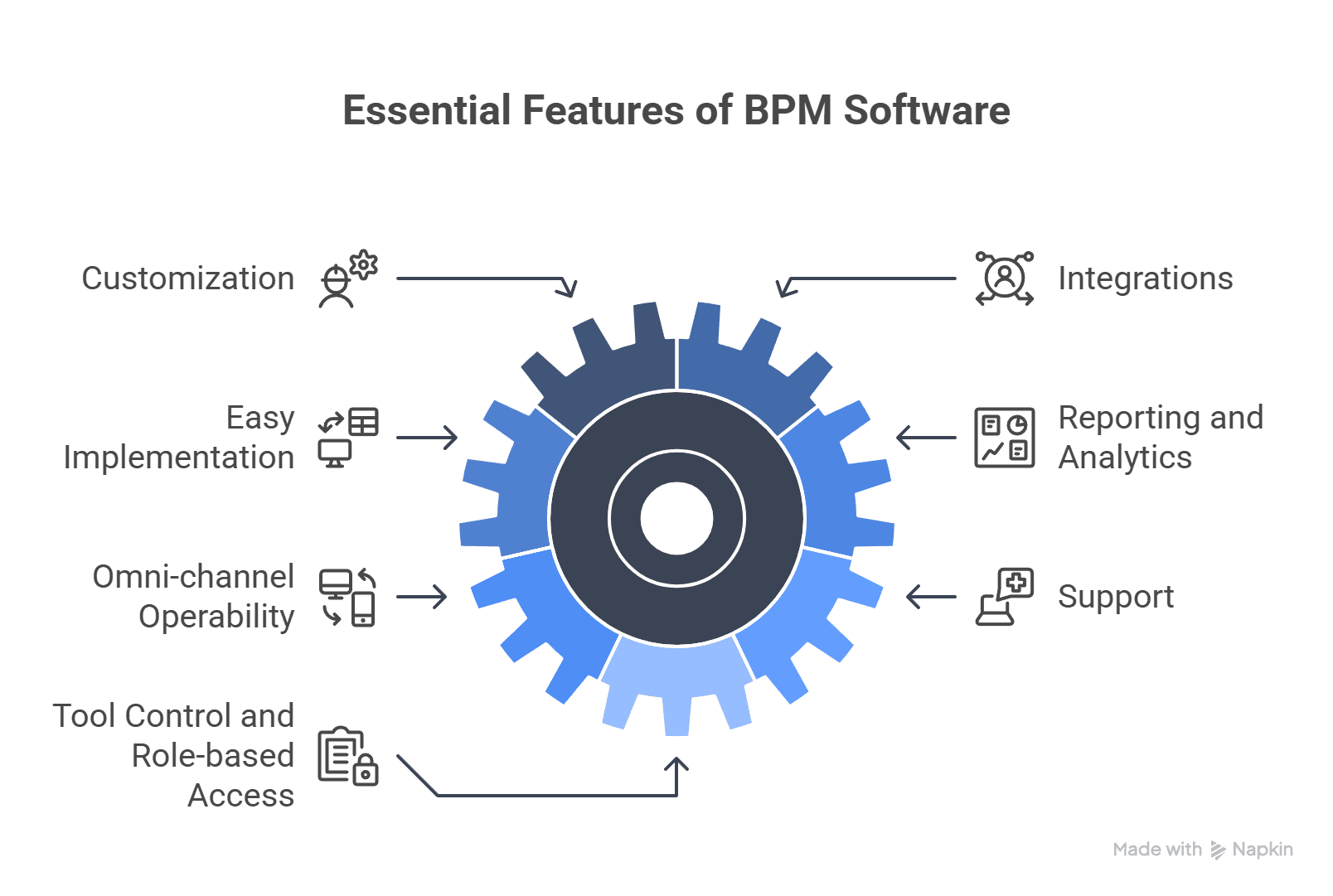
1. Customisation
The Bpm software must be customizable as per the requirements of your business. The software must be flexible to adapt to the expansions and changes that might crop up in the future. Customizability and scalability are a must for BPMS solutions.
2. Integrations
Prior to BPM software implementation, businesses will have existing systems and software that are already running. Implementing a BPM solution must not disrupt the working of existing systems. Seamless integration with existing systems is a must-have feature of BPMS software. When the BPM tool integrates with existing software, data exchange between tasks becomes easy and quick. You must choose software that supports a range of integrations.
3. Easy implementation
Choosing a business process management software simplifies the implementation and usage greatly. Cloud-based BPM systems can be installed within minutes, as opposed to on-premise systems that take days or even months. Working on cloud-BPM solutions is comparatively easy with intuitive dashboards and user interfaces. Dependence on the IT team is significantly reduced by using software that is easy to use and install. Look for software that provides templates and drag-and-drop features that do not require coding knowledge.
4. Reporting and analytics
The BPMS software must provide real-time reporting and analytics on process performance and task statuses. Having a bird’s eye view of the entire process enables better control over process performance. The software must enable the real-time gathering of process data and present it in the form of an easily readable and understandable format. These reports can be used to measure the efficiency of process management. Process analytics also throws light on how the current process is performing and whether optimal results are delivered by each task in the process.
5. Omni-channel operability
Staying connected on the go has become the norm for business operations. The business process management system must support seamless interconnectivity between multiple channels and devices used for business operations. Interconnectivity between desktop, ios, and Android devices is a must for easy collaboration.
6. Support
BPM software is not the “fit-and-forget” type, where you install the software and forget about it. You require constant support even after you install the software. Any issues that might arise during the installation or use of the software must be addressed immediately. Choose a software that provides comprehensive support that helps businesses deal with issues quickly and efficiently.
7. Tool control and role-based access
Business data must be handled very carefully. To secure business data, the BPMS tool must provide strict tool control features via profiles and role-based access. Role-based access to business data ensures that it is not misused or duplicated by unauthorised personnel. A single sign-on feature in the software and a security-based interface for logging into the software are a must-have feature that ensures data security and safety.
Cflow is a cloud-BPM tool that provides a rich feature set that covers all of the above features and much more. This workflow automation tool supports digital strategies for organizations that demand agility, visibility, and cost efficiency. The visual form designer in Cflow makes it super easy to create workflow forms without any coding knowledge. Users can create customized workflows according to the requirements of their businesses.
Implementing robust BPM tools requires an objective approach to analysing the current processes and identifying areas of improvement. Process owners also need to be flexible while creating process rules, which gives people the power to make sensible decisions and make changes wherever needed. While implementing BPMS software, it is important to empower teams rather than control them. Process owners must go the extra mile to ensure that everyone is on board with the new system from the start.
Things to Consider When Implementing BPM Software
Implementation of BPM software can be a daunting task. As it is a solution that would completely alter the work dynamics of the organization, a shift from a manual to an automated setup can be a huge initiative to take up. Here are some tips to follow during the implementation process of BPM software.
Follow an Objective Approach
An objective implementation of the process removes the influence of any bias. For this, step away from the owner’s perspective and think from the shoes of the customers/clients. This will allow the organisation to recognise their customers/clients’ needs and what satisfies them. The conclusion drawn from the objective approach can be used to choose the right tool and implement it that would benefit both the organization as well as the customers/clients.
Involve the Employees in BPM Implementation
The team members or employees of the organisation are the section that is going to be mainly involved in the processes, even after the implementation of BPM software. The employees have to be confident and involved in the new system. To achieve this, the employers have to properly communicate with the employees regarding the new approach that is being adopted. Reason out to them why this particular tool is chosen and what the organisation is aiming to achieve through this. Questions like, How does this solution solve the issues in the business? And how it is the best-suited tool for the working environment. It is ideal to provide proper training for the employees to easily adapt to the change and start working comfortably.
Be Flexible
It is important to understand that when an organisation is adapting to a completely new environment, it would naturally take all the factors involved to adjust to it at different paces. Therefore, a good amount of flexibility can be practised with the business rules and processes. With increased rigidity in the process, it would be burdensome for the employees to make sensible decisions.
Pay Attention to Details
As the features have already been discussed, paying attention to the details is crucial. Not all the software tools in the market would be the right fit for the work culture. Hence, understanding the basic functionalities of the software and what it caters to is ideal. List out the features the processes, and the team needs, and accordingly shortlist the tools to choose one. Dedicate to the problems in the working of the business and decide what type of BPM software is available that will resolve those problems.
Read the Must-Have Features
Discuss with the team members what exactly needs to be addressed with a business process management system. Decide on the processes that are going to be automated with the software and what the requirements are. Once that is sorted, the team will be able to decipher what features and elements the tool must have to address those needs. It is ideal to go for features that will have the right potential for the organisation. This will reduce the complexity of the training process for the employees as well.
Prepare a List of Pros and Cons
Preparing a list of the pros and cons of the shortlisted tools can help the team to a good decision. This allows the team to have clarity on what they are aiming to achieve. The right type of BPM solutions and the right tool can be chosen after this has been done.
Get Expert Advice to Find the Best Business Process Management Software
Implementing a new system into the work dynamics is a grave decision to make and has a great impact on the performance of the organizational functioning. Therefore, it is always essential to consult an expert who can navigate the purpose of the processes and the tool implemented in proper coordination.
Empower the Workforce
The implementation of the business process software must be to empower the workforce of your organization. In such a system, they have to be on the same page as any other entity involved in the change. Remember, the implemented software is merely a tool for the employees to work with. They have to be comfortable and confident with the tool that will simply aid them in their work.
Benefits of Using Business Process Management Software (BPMS)
As your business grows, it is challenging to personally track and monitor each process. Manual processes cannot scale up to evolving business requirements. Moreover, managers and team leads are forever in firefighting mode when handling business processes in manual mode.
Working with manual processes takes the focus away from process improvement by diverting it toward issue resolution. This is where business process management workflow software comes into the picture. The main benefits of using BPMS software are listed below:
1. Reduction of risks
A BPM tool provides deeper visibility into business processes, which makes it quick and easy to spot errors. Deeper visibility and transparency give organizations a way to work more efficiently and save time and money.
2. Improved collaboration
Running several tasks simultaneously requires good collaboration between tasks. BPMS tools foster better communication and collaboration between tasks so that everyone is on the same page.
3. Better operational control
Business process management software provides a comprehensive view of who is running what and where in a business process. The API dashboard in the software provides real-time information along with charts to help monitor progress and performance.
4. Better agility
Business process management software (BPMS) provides the ability to create smooth design processes so that changes can be made easily and quickly to align with the evolving needs of the organisation.
5. Improved productivity
Implementing the Best BPM software techniques in a process makes it easy to measure performance via key performance indicators. Tracking of KPIs helps process owners identify endpoints that require improvement and maximise revenues.
6. Reduced costs
Redundant tasks are streamlined when the BPM system is implemented. Repetitive tasks that do not require human intelligence can be automated based on BPM methods. The costs associated with such tasks are greatly reduced by using business process management software.
7. Improved employee satisfaction
When employees start working on high-value tasks that add value to the organisation and their careers, their work satisfaction automatically goes up. They feel more valued and are willing to contribute more to organisational growth. When routine tasks are taken care of by the software, employees get time to focus on meaningful tasks.
8. Increased efficiency
The traditionally followed manual setup has several drawbacks, like repetitive tasks, manual errors, and poor judgments that can cost the organisation so much. It compromises on the performance, productivity, compliance, time, and other essential resources. On the contrary, with the implementation of a business process management platform, all of these drawbacks are halted to a great extent, with very little to zero influence on the processes. With only a limited amount of resources being put to use, the processes yield the best results with automated business process management workflow software. Hence, the efficiency of the processes increases.
9. Enhanced Operational Transparency
All the tasks in the business operations are streamlined seamlessly and optimised effectively. This is achieved as the BPMS software allows the users to have visibility into the processes. The burden of manually tracking the operations is eradicated. The status and progress of the process can be gauged easily on the platform anytime. The employees can track all the reviews and approvals, any business-related actions, deadlines, the history of all the edits made on documents and data, etc.
10. No Space for Compliance Risks
Maintaining compliance is often a serious and difficult task to achieve. The recovery actions have to be quick enough in case of any non-compliance. A business process management platform empowers an organisation to set up and follow rigid rules and policies. This ensures that the complete functioning of the business is never out of compliance.
11. Regulated User Controls and Permissions
The security and privacy of the data and other important information are crucial to any organisation. A BPMS software allows regulated access to the platform. It clearly defines the user role access on the platform. The employers or the team managers can decide on the degree of accessibility that every employee can have. This way, the software maintains a restriction on the flow of information and data. Another good side of this benefit is that the employees are not bombarded with unnecessary information, which creates confusion.
When is the Right Time to Automate Your Processes with BPMS?
Main Purpose: Business Process Management Software (BPMS) is used to remove limitations and improve efficiency in operations.
Core Goal: The aim of implementing BPMS is to eliminate inefficiencies and create a smooth, seamless experience for users.
No Fixed Time: There’s no specific “right” time to automate. It depends on your business needs.
Scalability Needs: As your business grows, the need for a faster, smarter system becomes critical.
Performance Boost: BPMS helps improve overall business performance and responsiveness.
Industry Relevance: It ensures your organisation stays aligned with current trends and industry standards.
Employee Morale: Automation with BPMS can uplift the motivation and confidence of your team.
End-to-end workflow automation
Build fully-customizable, no code process workflows in a jiffy.
Top 15 Business Process Management Software (BPMS)
According to Grandview Research, the global business process management market size, which was valued at 14.46 billion USD in 2022, is expected to grow at a CAGR of 19.9% during the forecast period of 2023-2030.
The integration of AI into BPM has been a significant boost to market growth.
Integrating AI with BPMS software provided several benefits, like automation of repetitive tasks, predictive analysis, and improved customer experience. Another major contributor to the growth of the BPMS market is its adoption in the healthcare sector. Other industries that have adopted BPMS software include manufacturing, Banking and Financial Services, Insurance, and telecommunications.
We have put together a list of the best business process management software for 2025. You can choose from this exhaustive list based on the requirements of your business.
1. Cflow
Cflow is a no-code, AI-powered Business Process Management (BPM) software designed to streamline and automate organisational workflows. With its visual drag-and-drop builder and customizable forms, teams can digitise processes without writing a single line of code. It supports rule-based logic, seamless approvals, and real-time tracking across departments. Cflow enables efficient BPM implementation, boosts productivity, and ensures complete process visibility.
Features:
Visual workflow builder with drag-and-drop interface
Rule-based approvals and custom process logic
Real-time analytics and reporting dashboards
Pros:
No coding required; user-friendly interface
Highly scalable with customizable templates
Fast implementation with minimal training
Cons:
Limited integrations in the basic plan
Advanced analytics may require a higher-tier subscription
2. CMW Platform
CMW Platform offers a flexible BPM solution with a strong focus on workflow automation and collaboration. It allows you to create custom business applications without coding, making it ideal for non-technical users. Built-in tools for task tracking, form building, and reporting support agile business operations.
Features:
Cross-team project tracking and automation
Real-time reporting and dashboards
Pros:
Simple and intuitive interface
Easily handles complex, multi-team projects
Flexible for scaling across departments
Cons:
UI may feel outdated to some users
Limited third-party integrations
3. Appian BPM Suite
Appian combines low-code development with enterprise-grade process automation.
It enables businesses to build powerful applications quickly, integrate data, and automate workflows across systems. Known for its scalability and AI capabilities, it supports complex enterprise needs efficiently.
Features:
Unified low-code automation environment
AI-powered process optimisation
Rule-based decision engine
Pros:
Strong enterprise-grade capabilities
Excellent support for complex workflows
Seamless data integration
Cons:
Steep learning curve for beginners
Higher pricing for small businesses
4. Nintex
Nintex simplifies process automation with its drag-and-drop workflow designer and document generation tools. It’s highly suited for automating everyday business processes in HR, finance, and compliance. Strong integration with Microsoft 365 and Salesforce enhances its workflow execution power.
Features:
Visual process mapping
Form designer and document generation
Workflow automation and analytics
Pros:
No coding knowledge required
Strong collaboration features
Scalable for large organisations
Cons:
Licensing can get expensive
Limited mobile app capabilities
5. IBM Business Automation Workflow
IBM’s platform combines BPM with case management and advanced analytics. It supports digital process automation for complex enterprise environments and regulatory-heavy industries. Offers strong AI, machine learning, and real-time decision-making capabilities.
Features:
Workflow and decision automation
Content and data capture
AI and analytics integration
Pros:
Enterprise-ready platform
End-to-end automation with AI
Robust documentation and support
Cons:
Complex setup and management
Best suited for large enterprises
6. BeSlick
BeSlick focuses on process management with built-in task automation and accountability tracking. Designed for SMEs and consultancies, it helps teams consistently execute repeatable processes. Its intuitive UI and checklist-driven workflows improve compliance and team productivity.
Features:
Workflow and form builder
Process reports and templates
Task assignment tracking
Pros:
Simple and clean UI
Quick onboarding for teams
Helpful prebuilt templates
Cons:
Basic automation features
Limited customisation options
7. Zoho Creator
Zoho Creator is a low-code platform for building custom business apps and workflows. Its cloud-based automation tools make it suitable for small to mid-sized businesses with dynamic process needs. Integrates well with other Zoho tools and offers real-time insights.
Features:
Drag-and-drop app builder
Form creation and workflow automation
Real-time data collection
Pros:
Fast to deploy
Great for small and mid-size businesses
Affordable pricing
Cons:
Complex features may require scripting
Limited offline capabilities
8. Process Street
Process Street provides a checklist-based BPM system for recurring workflows and team collaboration. Users can create, track, and optimise processes without technical knowledge. Great for onboarding, SOP management, and daily task coordination in remote teams.
Features:
Drag-and-drop workflow creation
Recurring checklists and SOPs
Automation via Zapier and integrations
Pros:
Easy for beginners
Great for task tracking
Affordable entry-level plan
Cons:
Lacks advanced BPM features
Limited reporting capabilities
9. Pipefy
Pipefy is a no-code workflow management platform for automating business processes and approvals. It empowers teams to build workflows with conditional logic, forms, and automation triggers. Popular for procurement, finance, and HR teams seeking transparency and control.
Features:
Workflow templates and custom fields
Integration with CRMs and ERPs
Form automation and approvals
Pros:
Highly flexible process builder
Strong focus on standardisation
Good UI for complex workflows
Cons:
Customisation may require training
Limited mobile experience
10. Kintone
Kintone helps teams build database-driven applications with customizable workflows and collaboration tools. Its visual interface allows easy data management, process tracking, and task assignment. Ideal for teams managing CRM, project management, or inventory processes.
Features:
App and workflow builder
Database functionalities
API and integration support
Pros:
Easy to create custom apps
Strong team collaboration tools
Good integration support
Cons:
UI may look dated
Slight learning curve for setup
11. iGrafx
iGrafx offers enterprise-grade process modelling, automation, and performance management tools. Best suited for businesses focused on compliance, digital transformation, and risk management. It supports BPMN standards and provides in-depth process analysis and optimisation insights.
Features:
End-to-end process modelling
Compliance and risk frameworks
Process intelligence and analytics
Pros:
Strong for regulated industries
In-depth performance tracking
Great for strategic planning
Cons:
Not beginner-friendly
Complex pricing structure
12. Studio Creatio
Studio Creatio is a low-code BPM suite that helps design, automate, and monitor complex workflows. It combines CRM and BPM capabilities in one platform for end-to-end process visibility. Perfect for industries like banking, insurance, and healthcare that need scalability and flexibility.
Features:
Process designer with no-code tools
Integration-ready infrastructure
Pros:
Excellent for rapid application development
Easy to transform manual processes
Scales well with growth
Cons:
Premium pricing
May require technical onboarding
13. Monday.com
Monday.com provides a highly visual platform for workflow automation and team collaboration. Users can build custom workflows, track tasks, and automate routine actions using simple rules. Great for marketing, operations, and project teams needing intuitive workflow tools.
Features:
Visual dashboards
Task automation rules
Team collaboration features
Pros:
Clean, intuitive UI
Good for non-technical users
Wide integration ecosystem
Cons:
Limited for complex BPM needs
Customisation can get costly
14. ProWorkflow
ProWorkflow is designed for project and task management with built-in time tracking and workflow features. It helps streamline approvals, resource allocation, and client communication. A good fit for creative teams and agencies managing multiple client deliverables.
Features:
Time tracking and task management
Project templates and Gantt charts
Report generation
Pros:
Great for time-sensitive teams
Simple and quick setup
Budget tracking features
Cons:
Less suitable for large enterprises
A few advanced BPM options
15. ClickUp
ClickUp offers robust project and process management with custom workflows, automation, and templates. It unifies tasks, docs, goals, and forms in a single workspace for better team alignment. Ideal for teams of all sizes looking to scale efficiently with automation.
Features:
Custom workflows and dashboards
Task automation and templates
Docs, chat, goals, and timelines
Pros:
Extremely flexible and customizable
Suitable for any team size
Strong free plan
Cons:
It can feel overwhelming with features
Occasional performance lags
Conclusion
Business Process Management Software (BPMS) is no longer a luxury— it’s a necessity for organisations aiming to stay competitive, agile, and efficient. From streamlining routine tasks to enabling cross-functional collaboration, the right BPM platform empowers teams to focus on high-impact work while ensuring consistency, compliance, and scalability. Whether you’re managing approvals, onboarding new hires, or improving customer experience, BPMS offers the structure and automation needed to run your business smoothly.
As processes grow more complex and customer expectations continue to rise, adopting a no-code, AI-powered BPM solution like Cflow can help transform your operations from reactive to proactive. Start small, involve your team, and scale your automation journey with confidence. The sooner you implement BPM, the faster you’ll unlock the full potential of your people, systems, and processes.
Sign up for a free trial to know more.
FAQ
What is the difference between ERP and BPMS?
ERP (Enterprise Resource Planning) software manages core business functions like finance, HR, and inventory in an integrated system. BPMS (Business Process Management Software) focuses on automating, optimising, and improving workflows across departments. ERP is system-centric, while BPMS is process-centric and supports continuous process improvement and agility.
How to use BPMS?
BPMS is used by mapping out existing processes, designing workflows using visual tools, and applying rules to automate tasks. It enables businesses to monitor performance, identify bottlenecks, and optimise operations. Start by selecting a BPMS, modelling your process, automating repetitive tasks, and tracking performance through real-time dashboards.
Which is the best BPM tool on the market?
There’s no one-size-fits-all solution, but Cflow, Appian, Nintex, and Pipefy are widely recognised for their no-code capabilities and scalability. The best tool depends on your business size, industry, and workflow complexity. Cflow stands out for its ease of use, quick deployment, and powerful automation features without requiring coding skills.
What are the 4 types of business processes?
Operational Processes – Core activities that deliver value to customers (e.g., order fulfilment).
Supporting Processes – Internal services like HR, IT, and accounting.
Management Processes – Strategic activities such as budgeting and performance monitoring.
Development Processes – Innovation and improvement tasks, like product development or R&D.
What are the six core elements of business process management?
Process Design – Defining workflows, roles, and sequences.
Modelling – Visualising processes and identifying improvements.
Execution – Automating workflows using BPM tools.
Monitoring – Tracking performance and KPIs.
Optimisation – Improving process efficiency continuously.
Governance – Ensuring compliance, security, and policy alignment.
Related Articles:
- Understanding the Need for BPM Solutions for Successful Business Operations
- What is a BPM Platform? A Complete Guide to Business Process Management in 2025
- 9 Must-Have Features of a BPM Suite
- Business Process Management in Banking and Financial Industry
- Top 3 reasons why Zero code BPM is essential for your business
- Best BPM Companies to Consider in 2025
What would you like to do next?
Automate your workflows with our Cflow experts.

